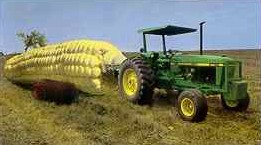


![]() he number of harvestable
kernels per ear is an important contributor to the grain yield potential of a
corn plant. Severe plant stress during ear formation may limit the potential
ear size, and thus grain yield potential, before pollination has even occurred.
Optimum growing conditions set the stage for maximum ear size potential and
exceptional grain yields at harvest time. The size of what will become the
harvestable ear begins by the time a corn plant has reached knee-high and
finishes 7 to 10 days prior to silk emergence.
he number of harvestable
kernels per ear is an important contributor to the grain yield potential of a
corn plant. Severe plant stress during ear formation may limit the potential
ear size, and thus grain yield potential, before pollination has even occurred.
Optimum growing conditions set the stage for maximum ear size potential and
exceptional grain yields at harvest time. The size of what will become the
harvestable ear begins by the time a corn plant has reached knee-high and
finishes 7 to 10 days prior to silk emergence.
Ear Shoot Development. An axillary meristem forms at each stalk node (behind the leaf sheath) beginning at the base of the stalk and continuing toward the top (acropetally for you wordsmith fans) except for the upper six to eight nodes of the plant. Each axillary meristem initiates husk leaves at the nodes of the ear shank and eventually an ear itself at the tip of the ear shank.
By about the V5 or V6 stages of development (five to six visible leaf collars), the growing point (apical meristem) of the corn plant finishes the task of initiating leaf primordia and completes its developmental responsibilities by initiating the tassel primordium of the plant. At about the same time that the tassel is initiated, the uppermost harvestable (and final) ear is also initiated (Lejeune and Bernier, 1996). This uppermost ear is normally located at the 12th to 14th stalk node, corresponding to the 12th to 14th leaf.
Careful removal of the leaves from a stalk, including leaf sheaths, at about growth stage V10 (ten visible leaf collars) will usually reveal 8 to 10 identifiable ear shoots. Each ear shoot originates at a stalk node, behind its respective leaf sheath. At growth stage V10, these tiny ear shoots primarily consist of husk leaf tissue. The developing ears themselves are only a fraction of an inch in length.
Initially, the ear shoots found at the lower stalk nodes are longer than the ones at the upper stalk nodes simply because the lower ones were created earlier. As time marches on, the upper one or two ear shoots assume priority over all the lower ones and ultimately become the harvestable ears. Development of the upper ears is favored over the lower ones because of hormonal “checks and balances”, plus the proximity of the upper ear to the actively photosynthesizing leaves of the upper canopy.





Ear Size Determination. Row number and kernel number per row are two yield components in corn. Every pair of rows is generally equal to about 20 bushels per acre (for average populations and ear lengths). For a 16-row ear, one kernel per row is equal to about five bushels per acre (for average populations). Typically, from 750 to 1000 ovules (potential kernels) develop on each ear shoot. The number of kernel rows multiplied by the number of kernels per row determines total kernel number per ear. Actual (harvestable) kernel number per ear averages between 400 and 600.
Kernel row number determination of the uppermost ear begins shortly after the ear shoot is initiated (V5 to V6) and is thought to be complete by growth stage V12. Like so many other processes in the corn plant, kernel row number determination on an ear proceeds in an acropetal fashion (from base to tip).
Kernel rows first initiate as “ridges” of cells that eventually differentiate into pairs of rows. Thus, row number on ears of corn is always even unless some sort of stress disrupts the developmental process. True row number is often difficult to visualize in tiny ears dissected from plants younger than about the 12-leaf stage.
Row number is determined strongly by plant genetics rather than by environment. This means that row number for any given hybrid will be quite similar from year to year, regardless of growing conditions. Some exceptions to this include potential injury from the postemergence application of certain sulfonylurea herbicides or nearly complete defoliation by hail damage prior to growth stage V12.
The potential number of kernels per row is complete by about one week before silk emergence from the husk. Kernel number (ear length) is strongly affected by environmental stresses. This means that ear length will vary dramatically from year to year as growing conditions vary. Severe stress can greatly reduce potential kernel number per row. Conversely, excellent growing conditions can encourage unusually high potential kernel number.